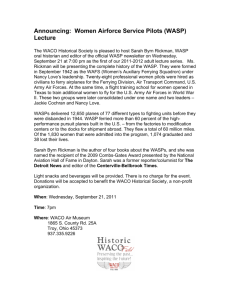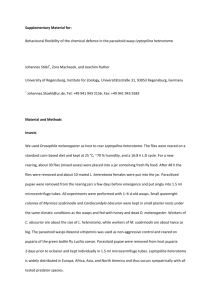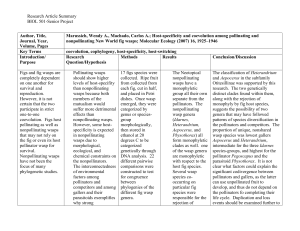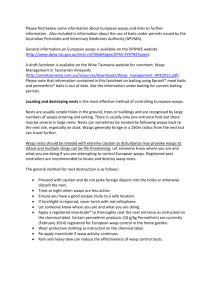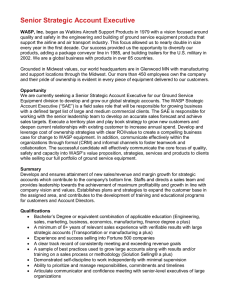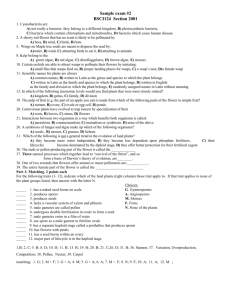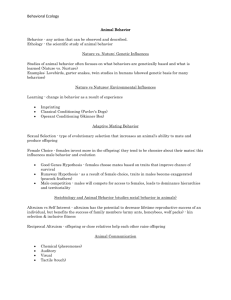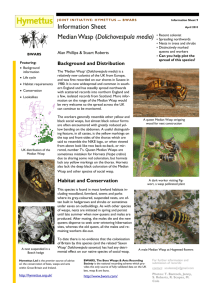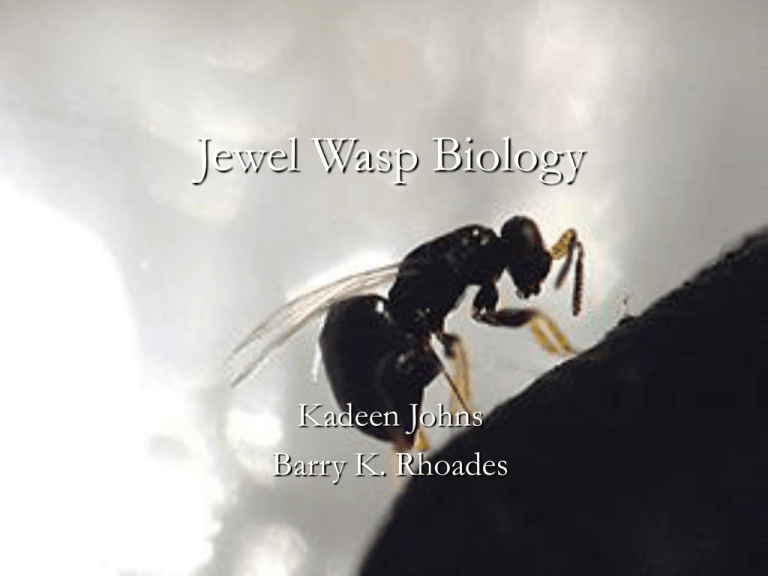
Jewel Wasp Biology
Kadeen Johns
Barry K. Rhoades
Nasonia Vitripennis Life Cycle
Characteristics of Nasonia vitripennis
Wasps are parasitoid on fly puparia
Females oviposit up to 40 eggs
Several host species, including Sarcophaga bulatta
Complete metamorphosis with ~14 day developmental
cycle
Jewel wasps are haplodiploid – gender determined by
ploidy
Flightless, haploid males have short
wings - mate at eclosion site
Diploid females have longer wings,
larger bodies – locate and oviposit hosts
Mating takes place immediately after eclosion
Three different stock eye colors - wild, scarlet, and oyster
Nasonia vitripennis Reproduction
Female sex determination of offspring
Mated female
(stores sperm)
Diploid fertilized egg
Haploid unfertilized egg
Female offspring
Male offspring
Haplodiploid genetics of eye color
Female Phenotypes:
Wild
Scarlet
Oyster
+.+/+.+ +.st/+.st oy.+/oy.+
+.+/+.st
+.+/oy.+
+.st/oy.+
Wild
+.+
Male Phenotypes:
Scarlet
Oyster
+.st
oy.+
Maternal Determination of Progeny
Gender in Nasonia vitripennis
Female stores sperm after mating in spermatheca
Female can deposit either fertilized or unfertilized eggs
Female can detect prior ovipositions into host puparium and
control sex ratio of offspring (F1) during oviposition
For single oviposition, females mate with brothers upon eclosion
Ideal F1 sex ratio differs depending on oviposition exclusivity and
sequential order – facultative sex ratio adjustment
First wasp (primary oviposition) -> predominantly female progeny –
maximizes # of F2 secnd generation female offspring
Subsequent wasps (superoviposition) -> relatively more males –
outcompete primary wasp’s few male F1 progeny for reproductive access to
F1 females
Multiple female wasps directly competing -> relative number of male
progeny should increase with number of competing wasps
Distinguishing Females from Males
sorting pupae – to isolate virgin females
Distinguishing Females from Males
Distinguishing Females from Males
Eye Color Variants
Facultative Sex Ratio Adjustment
Based on Oviposition Sequence
Single fly puparium exposed sequentially to 2 female wasps
Day1 – female wasp 1, Day 2 – female wasp 2
Purebred eyecolor stocks used to determine offspring parentage
Balanced design with repetitions
W1S2 x 4, S1W2 x4 – 4 groups
O1S2 x 4, S1O2 x 4 – 3 groups
Data included:
if and only if female progeny from both parental stocks
16 out of 56 fly puparia -> 462 wasps
Offspring Sex Ratio for Primary vs.
C2 = 36.5, d.f. = 1, p < .001
Secondary Oviposition
Offspring
Male
Female
M/F Ratio
1st Wasp
78
225
0.35
2nd Wasp
86
73
1.18
Offspring Sex Ratio # Males/#Females
1.4
1.2
1
0.8
0.6
0.4
0.2
0
1st wasp
2nd wasp
Oviposition Order
Facultative Sex Ratio Adjustment
Based on Female Competition
Single fly puparium exposed to 1 or more female wasps concurrently
1, 2, 4, or 8 female wasps – 4 day exposure
Repetitions – 7 sets x 4 conditions
Data included:
if and only if female progeny eclosed
23 out of 28 fly puparia -> 1320 wasps
C2 = 26.1, d.f. = 3, p < .001
Offspring Sex Ratio with
Oviposition Competition
Male
Female
M/F Ratio
1 Wasp
95
150
.63
2 Wasps
157
115
1.37
4 Wasps
234
147
1.59
8 Wasps
249
173
1.44
Offspring Sex
Ratio # Males/# Females
Offspring
2.00
1.50
1.00
0.50
0.00
1 Wasp
2 Wasps
4 Wasps 8 Wasps
Number of Ovipositing Wasps

